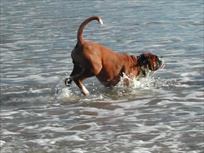 Boxer Dog Lovers Welcome here
Boxer Dog Lovers Welcome hereHealth
BOXER DOGS have their fair share of health issues. White boxers also have a tendency to deafness.
In America white boxers are not used for breeding (by registered breeders) to reduce the risk of some health problems associated with white boxers. However, this does not mean that they will not make a good pet, just be prepared for deafness.
Often older boxers will be seen with nodules on various parts of their body. However, in most cases these are best not removed.Boxers like many other breeds suffer from cancers.
Many of these problems are associated with diet.
The most serious condition that is associated with boxers is bloat. Why, because it can be fatal.
The technical name for bloat is "Gastric Dilatation-Volvulus" (
GDV). Bloating of the stomach is often related to swallowed air (although food and fluid can also be present). It usually happens when there's an abnormal accumulation of air, fluid, and/or foam in the stomach ("gastric dilatation"). Stress can be a significant contributing factor also. Bloat can occur with or without "volvulus" (twisting). As the stomach swells, it may rotate 90° to 360°, twisting between its fixed attachments at the esophagus (food tube) and at the duodenum (the upper intestine). The twisting stomach traps air, food, and water in the stomach. The bloated stomach obstructs veins in the abdomen, leading to low blood pressure, shock, and damage to internal organs.
The combined effect can quickly kill a dog.
Hip Dysplasia is a common condition of large breed dogs and many boxer dog owners have heard of it.
The term dysplasia means abnormal growth thus hip dysplasia means abnormal growth or development of the hips.
Hip dysplasia occurs during the growing phase of a puppy, usually in large breed puppies, and essentially refers to a poor fit of ball and socket nature of the hip. This is why you should take care on how much exercise your Boxer puppy has when young.
Because the condition can be heriditory it is best to check with a breeder first. However, the condition has been known to "miss" a generation.
It can cause discomfort in a young dog or may not become apparent until they are old when artheritic joints are the outward sign of the problem.
